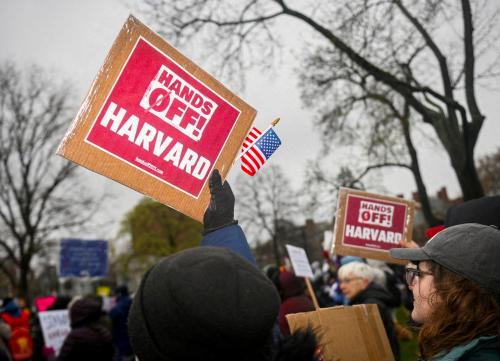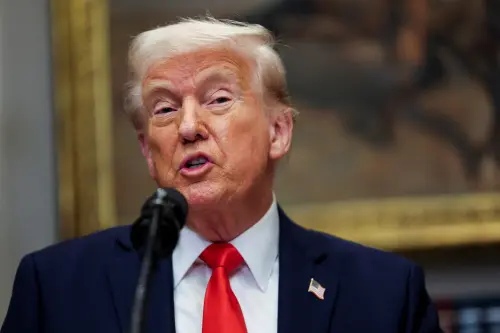For decades, studying in the United States stood as a beacon of aspiration, a rite of passage for ambitious students across the globe seeking not just academic excellence but a springboard into global opportunity. Prominent examples include Microsoft CEO Satya Nadella and Zoom founder Eric Yuan, who first arrived in the United States as international students from India and China, respectively.
But today, this once-stable pathway is increasingly shadowed by geopolitical tensions. In the wake of the Trump administration’s immigration crackdown, more than 4,700 students have lost their F-1 or J-1 visa status since March (although the administration temporarily restored some of them on April 25, details remain hazy). Secretary of State Marco Rubio claimed that many of these international students came “not just to study but to participate in movements that vandalize universities, harass students, take over buildings, and cause chaos.” Yet, in most cases, the reasons for their loss of legal status remain opaque. Officials have pointed to minor infractions—such as a single speeding ticket—but even that does not explain many cases. A Chinese international student at Syracuse University, where I teach, recently had his visa unexpectedly revoked. His advisor noted that he maintains an impeccable record and does not even own a car—making the revocation all the more perplexing.
America is losing Chinese students
Visa revocations affect international students from many countries, but Chinese students are particularly vulnerable. As China remains one of the largest sources of international students in the United States, ongoing bilateral tensions and trade restrictions—such as tariffs—have heightened anxiety among students and their families. Chinese student numbers in the United States have declined steadily since their peak of about 372,000 in 2019 to about 278,000 now—a greater than 20% decline, reflecting the impact of pandemic disruptions and bilateral tensions.
Beijing has taken notice. Twin advisories from China’s Ministry of Culture and Tourism and Ministry of Education show how politicized international education has become. The tourism advisory warned of travel risks linked to the “deterioration of Sino‑U.S. economic and trade relations,” while the education notice—the ministry’s first since 2021—cited new Ohio legislation aimed at limiting academic partnerships with Chinese institutions. Together, these statements are more than routine guidance; they signal that the United States may no longer be a safe or even a viable destination for Chinese students.
International students bolster the U.S. economy
The consequences extend far beyond diplomacy. The Institute of International Education estimates that U.S. colleges enrolled about 1.1 million overseas students in 2023‑2024, injecting roughly $43.8 billion into the economy and supporting 378,175 jobs. Nearly 25% of those students were from China, whose families spent about $14.3 billion on tuition and living costs in the United States in 2023 alone.
The nearly 100,000-student decline in Chinese enrollment in the United States since 2019 translates into billions in lost tuition revenue. Universities in states like California, New York, Illinois, and Massachusetts—top destinations for Chinese students—have felt the financial strain acutely. Compounding the challenge, recent cuts to federal research funding have further destabilized academic departments that rely on both tuition and grant support. In engineering and computer science—fields especially popular among Chinese graduate students—colleges are struggling to fill seats, while also contending with shrinking research budgets. The combined effect is a growing crisis in departmental sustainability.
And they are critical to talent and innovation
The economic cost is real and mounting, but the deeper, more enduring cost is talent.
The National Science Board’s 2024 Science and Engineering Indicators report highlighted the critical role of international students in the U.S. science and engineering fields. In key fields like computer science—whose subfields include artificial intelligence (AI) and quantum computing—nearly 60% of doctoral degrees were awarded to international students, with Chinese students comprising the largest group.
These students are not only classroom learners; they are research assistants, innovators, patent holders, and coauthors of cutting-edge science. The United States has long benefitted from the “educate and retain” model: train global talent, offer post-study opportunities, and allow them to fuel the economy. Many of these roles cannot be filled by the domestic workforce alone—experts call this “STEM talent crisis.” Tapping into the pool of international graduates already trained in the United States is not just advantageous; it is essential. Undermining this pipeline risks eroding the very foundation of America’s innovation ecosystem.
National security amid a climate of fear
While national security concerns must be taken seriously, they should be addressed with precision and transparency. The now-defunct China Initiative—meant to uncover and prosecute economic espionage among Chinese students and researchers—ultimately cleared most of those investigated and was disbanded after widespread criticism of racial profiling. Protecting national interests requires tailored, evidence-based measures that avoid broadly stigmatizing international students.
Today’s policy environment is doing just the opposite. Increasingly, international students fear that even brief travel outside the United States could prevent their return. This fear is no longer abstract. Nationwide, international students tell each other not to return to their home country during the upcoming summer break for fear of not being able to reenter. Some have decided to skip family funerals, weddings, and major life events back home because of the risk of being denied reentry.
This climate carries a cost that is less visible but deeply consequential: the erosion of U.S. soft power. For much of the 20th and early 21st centuries, the allure of American education served as one of the country’s most effective instruments of diplomacy. Students came, studied, built connections, and became bridges. That soft power—earned not through coercion but through the appeal of openness and opportunity—is now fraying. In its place grows a perception of a closed, suspicious, and increasingly inhospitable America.
If prospective students begin to see a U.S. education as no longer worth the financial, emotional, or political risk, they will look elsewhere. Countries like Canada, the U.K., Australia, and Japan—each of which has seen post-pandemic growth in Chinese student enrollment—stand ready to welcome them. Increasingly, China’s rapidly expanding and improving higher education sector is also becoming a compelling alternative. Many of China’s brightest students are now choosing to stay home, enrolling in top domestic institutions for both undergraduate and graduate studies.
So, can studying in the United States survive geopolitics? Only if policymakers recognize the long-term damage of short-term fear. National security is essential—but indiscriminate suspicion is self-defeating. The United States must decide whether it wants to remain a magnet for the world’s brightest minds—or whether it will let that magnetism erode by mistrust, nationalism, and shortsighted policy. The stakes are clear: what’s at risk is not just enrollment numbers or university budgets—it’s the future of American innovation and the country’s standing in the world.
The Brookings Institution is committed to quality, independence, and impact.
We are supported by a diverse array of funders. In line with our values and policies, each Brookings publication represents the sole views of its author(s).







Commentary
Can studying in the US survive geopolitics?
What’s at risk is not just enrollment numbers or university budgets—it’s the future of American innovation and the country’s standing in the world.
May 1, 2025